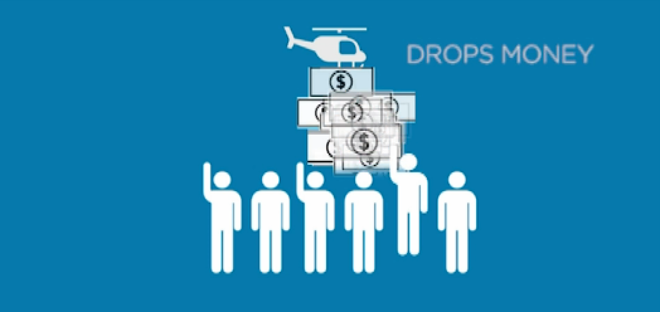Advertisement
Advertisement
The Weight Of Helicopter Money Could Crash The Helicopter
By:
Helicopter Money is a new financial jargon this is making the circuit as of late. Many traders and speculators think the term just simply means easy money
Helicopter Money is a new financial jargon this is making the circuit as of late. Many traders and speculators think the term just simply means easy money pushed into the markets by central banks or is the same as quantitative easing or stimulus, but there are distinct differences between the terms. Quantitative easing took the markets by storm when introduced at by Ben Bernanke at his Jackson Hole speech. Bankers over the past years have flooded the global markets with this easy money. The central bank buys assets, usually government bonds, with money it has “printed” – or, more accurately, created electronically. It then uses this money to buy bonds from investors such as banks or pension funds. This increases the overall number of usable funds in the financial system. Making more money available is supposed to encourage financial institutions to lend more to businesses and individuals. Just about every major central bank from the US Fed to the Bank of Japan, including the ECB and the BoE have all adopted and used QE over the past few years. The biggest concern is that pumping more money into the economy could ultimately lead to an inflation problem. Others argue that the extra money has just bolstered the price of some assets such as shares and property in some countries. This process has helped reduce government borrowing costs, for sure. Central banks also send back to their governments most of the interest received on assets purchased through quantitative-easing programs. Governments essentially are paying interest to themselves.
Helicopter money is a newer form of stimulus and very scary. It is untried and untested and once the money is issued or paid out it is out of the control of the government. This is a type of fiscal stimulus applied directly to the economy. It’s called helicopter money because of the illusion of dumping currency from the sky to people who will rapidly spend it, thereby creating demand, jobs and economic growth. Central banks can raise and lower interest rates and buy and sell securities, but that’s it. They can thereby make credit cheap and readily available, yet they can’t force banks to lend and consumers and businesses to borrow, spend and invest. That undermines the effectiveness of QE; as the proverb says, you can lead a horse to water, but you can’t make it drink.
All of the QE activity over the past several years by the Fed, the Bank of England, the European Central Bank, the Bank of Japan and others has failed to significantly revive economic growth. U.S. economic growth in this recovery has been the weakest of any post-war recovery. Growth in Japan has been minimal, and economies in the U.K. and the euro area remain under pressure.
Handing people cash in the hope they’ll spend it—is a central bank’s ultimate weapon in the fight to boost economic growth and avoid deflation. The trouble is, it might not work.
The idea is likely to fill Washington’s conference rooms, bars and hotels this week, as the International Monetary Fund holds its spring meeting of the world’s financial policymakers. Frustration is mounting that other stimulus measures have not had much effect.
In theory, helicopter money would be a boon for stocks and bad for bonds with longer-term yields rising sharply with inflation expectations. PIMCO, one of the world’s biggest bond fund managers, has been warning policymakers off.
Helicopter money is a form of policy easing envisaged by U.S. economist Milton Friedman, using the metaphor of a helicopter dropping money. The point is that it’s funded by a permanent increase in the money supply, not temporarily boosted by bond issues that eventually have to be paid back.
It could take many forms: QE combined with fiscal expansion; direct cash transfers to governments; or, the most radical option, direct cash transfers to households via checks, bank transfers or state pension payments.
By common consensus, helicopter money would probably be delivered first in the Eurozone or Japan, where monetary policy in recent years has been ultra-loose and stimulus has been worth trillions of euros and yen.
The risk it won’t pack quite the intended punch may not prevent the helicopters from taking off, if policymakers feel growth is too sluggish and deflation remains a threat. As government officials and administrations and central bankers are backed against the wall they are grasping for any hopes to turn the cycle. Once the money reaches the hands of the consumer, there is no guarantee what they might do with it. They could pay down debt instead of spend it, they could bank it and not spend it or once spent they can just forgot they ever had it. This could be one costly experiment for governments.
About the Author
Barry Normanauthor
Latest news and analysis
Advertisement
